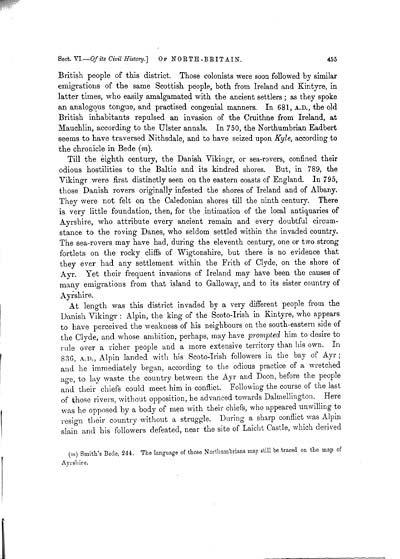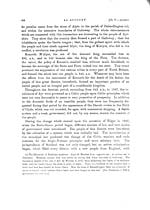Volume 6
(13) Page 455
Download files
Individual page:
Thumbnail gallery: Grid view | List view

455 British people of this district. Those colonists were soon followed by similar emigrations of the same Scottish people, both from Ireland and Kintyre, in latter times, who easily amalgamated with the ancient settlers ; as they spoke an analogous tongue, and practised congenial manners. In 681, A.D., the old British inhabitants repulsed an invasion of the Cruithne from Ireland, at Mauchlin, according to the Ulster annals. In 750, the Northumbrian Eadbert seems to have traversed Nithsdale, and to have seized upon Kyle, according to the chronicle in Bede (m). Till the eighth century, the Danish Vikingr, or sea-rovers, confined their odious hostilities to the Baltic and its kindred shores. But, in 789, the Vikingr were first distinctly seen on the eastern coasts of England. In 795, those Danish rovers originally infested the shores of Ireland and of Albany. They were not felt on the Caledonian shores till the ninth century. There is very little foundation, then, for the intimation of the local antiquaries of Ayrshire, who attribute every ancient remain and every doubtful circum- stance to the roving Danes, who seldom settled within the invaded country. The sea-rovers may have had, during the eleventh century, one or two strong fortlets on the rocky cliffs of Wigtonshire, but there is no evidence that they ever had any settlement within the Frith of Clyde, on the shore of Ayr. Yet their frequent invasions of Ireland may have been the causes of many emigrations from that island to Galloway, and to its sister country of Ayrshire. At length was this district invaded by a very different people from the Danish Vikingr : Alpin, the king of the Scoto-Irish in Kintyre, who appears to have perceived the weakness of his neighbours on the south-eastern side of the Clyde, and whose ambition, perhaps, may have prompted him to desire to rule over a richer people and a more extensive territory than his own. In 836, A.d., Alpin landed with his Scoto-Irish followers in the bay of Ayr; and he immediately began, according to the odious practice of a wretched age, to lay waste the country between the Ayr and Doon, before the people and their chiefs could meet him in conflict. Following the course of the last of those rivers, without opposition, he advanced towards Dalmellington. Here was he opposed by a body of men with their chiefs, who appeared unwilling to resign their country without a struggle. During a sharp conflict was Alpin slain and his followers defeated, near the site of Laicht Castle, which derived (m) Smith's Bede, 244. The language of those Northumbrians may still be traced on the map of Ayrshire.
Set display mode to:
![]() Universal Viewer |
Universal Viewer | ![]() Mirador |
Large image | Transcription
Mirador |
Large image | Transcription
Images and transcriptions on this page, including medium image downloads, may be used under the Creative Commons Attribution 4.0 International Licence unless otherwise stated. ![]()
| Caledonia, or, An account, historical and topographic of North Britain from the most ancient to the present times > Volume 6 > (13) Page 455 |
|---|
| Permanent URL | https://digital.nls.uk/74531056 |
|---|---|
| Description | Vol. VI. |
|---|---|
| Attribution and copyright: |
|

